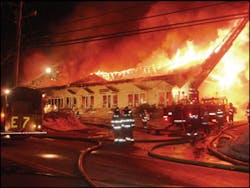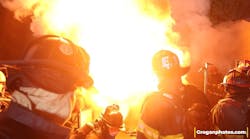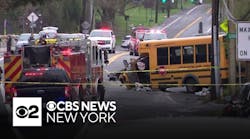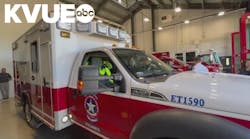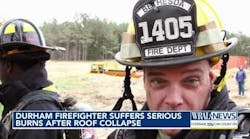BELMONT FIRE DEPARTMENT
Chief: Richard Siegel
Personnel: 11 career firefighters and 24 call firefighters, plus 28 volunteer firefighters from the Winnisquam Fire Department
Apparatus: Five engines, one tanker, three forestry units, one medium-duty rescue, three ambulances
Population: 7,005 town residents (12,000 in summer)
Area: 32 square miles
Truss failure, frozen lines and water supply problems confronted firefighters during a six-alarm fire at a strip mall in Belmont, NH. The nighttime fire, battled in below-zero weather, destroyed the 28,040-square-foot strip mall and caused $2 million in losses. Mutual aid was called in from numerous communities.
The original building was constructed in the late 1970s with additions erected in 1981, 1984 and 1985. The entire building was of wood-frame construction and a wood-truss roof with plywood and asphalt shingles. A metal roof was put over the existing roof in the late 1990s. Currently occupying the mall were the book store Read All About It, Country Time Antiques (on the first floor and in the basement), Studio Lighting, Eggcelent Restaurant, Nails 2000 and the Galaxy Gym. The building contained heat detectors and manual pull stations connected to Central Alarm Monitoring.
The Belmont and Winnisquam fire departments were dispatched to an automatic alarm from Read All About It at 7:04 P.M. A telephone call received a minute later from a nearby business confirmed a fire at the store. Responding on the automatic alarm were Belmont Engine 2 with Lieutenant Bob Laraway and Firefighter-Paramedic Gina Harris and the 2,500-gallon Belmont Tanker 1 under the command of Deputy Chief Brad Lawrence. Upon confirmation of the fire, Belmont Engines 1 and 4, Ambulances 1 and 2, and Rescue 1 responded with 15 firefighters and Winnisquam Engines 1 and 2 answered with four firefighters. The only business occupied at the time of the fire was the Galaxy Gym with fewer than 10 people inside. Patrons and employees were evacuated by two officers from the Belmont Police Department.
At 7:07, Winnisquam Lieutenant Rusty Wyatt arrived on scene and reported heavy smoke showing and requested a second alarm. Winnisquam Chief Kevin Nugent also reported heavy smoke from the eaves in front of Read All About It. Hearing the second-alarm request, Laraway jumped to a third-alarm "commercial response" at 7:12. Responding on the third alarm were Laconia Fire Department Engine 1 and Ladders 1 and 2, Gilford Fire Rescue Engines 1 and 2, Franklin Fire Department Engine 4 and Ladder 1, Sanbornton Fire Department Engines 1 and 3, Tilton-Northfield Fire Department Engines 1 and 2 and Ladder 1, Gilmanton Fire Rescue Engines 1 and 2, and Alton Fire Department Engine 2. Station coverage was provided by Barnstead Fire Rescue Engine 2 in Belmont, New Hampton Fire Department Engine 1 in Winnisquam and New Durham Fire Department Engine 1 in Gilmanton.
Belmont Engine 2 was positioned in front of the building on the A division near the corner with B division. Backdraft conditions that had been observed by both Winnisquam officers were no longer visible. Laraway saw light smoke conditions in the book store, and checking the rear of the building he found smoke venting from the B division gable and from the B-C corner. Laraway directed Winnisquam Engine 2 to begin a forward lay from Lake Winnisquam, 3,800 feet away, to the scene. The Belmont Police Department was requested to shut down Daniel Webster Highway to let the Winnisquam units lay a four-inch supply line. Laconia Engine 1 was directed to start a forward lay from a hydrant at the Belknap Mall, 2,800 feet away.
Laconia Ladder 1 was positioned in front of the building and set up to perform ventilation operations on the roof above the book store. After laying 1,200 feet of four-inch supply line, Laconia Engine 1 was positioned off the B side to protect an exposure 50 feet away, a 70-by-70-foot cement block building with a wood truss and steel roof.
Belmont Chief Richard Siegel arrived on scene at 7:19 and took command of the fire from a command post on Daniel Webster Highway. He assigned Belmont Deputy Chief Jim Davis to operations, Laconia Chief Ken Erickson as division A officer, Tilton-Northfield Chief Steve Carrier as division D officer, Franklin Chief Scott Clarenbach as division A ventilation, Gilford Captain John Beland as division B officer and Belmont Deputy Chief Brad Lawrence to accountability and manpower staging.
Crews from Belmont Engine 2 and Laconia Engine 1 stretched two attack lines from Belmont Engine 2 into positions along the front of the structure. One crew advanced a line into the book store and the other crew advanced a line into the antiques store. The crew in the book store encountered heavy smoke conditions down to eye level and observed fire in the rear of the store. The firefighters advanced the line and attacked the fire. The crew in the antiques store found little heat, but some smoke at the ceiling level. Firefighters had begun to pull the ceiling to check for extension when conditions rapidly deteriorated as the fire spread through the attic, forcing the crew to evacuate the store.
Beland took his crew and advanced an attack line equipped with a blitz fire nozzle from Laconia Engine 1 to the B-C corner to attack the fire. As the crew from Laconia Ladder 1 started opening the roof at 7:22, all interior attack crews reported heavy fire in the attic areas of the book store and the antiques store. The Laconia Engine 1 firefighters reported the fire was already over their heads in the antiques store and extending toward the D division. Laconia Ladder 1 reported that fire blew out as the crew made the first cut in the roof. These firefighters also reported they could hear the roof trusses failing over the book store and were forced to abandon roof operations.
Davis ordered all interior crews to evacuate the building and notified command that all operations would be defensive. All store fronts were ventilated and another attempt was made to ventilate the roof by a crew in Franklin's tower ladder, halfway down the complex over the restaurant. This operation was abandoned after only cutting a two-by-two-foot hole due to heavy smoke and heat conditions. The fire was rapidly spreading horizontally through the truss roof toward the exposure on the D division. This exposure was a second strip mall 25 feet from the fire building. The exposed structure was 100 by 300 feet, constructed similarly to the fire building.
The first hydrant supply was established 30 minutes into the fire. Belmont Engine 1 hooked onto the hydrant at Belknap Mall with 15 feet of six-inch suction and pumped the 1,200-foot supply line laid by Laconia Engine 1 to Belmont Engine 4. Belmont Engine 4 was placed inline and pumped the 1,600 feet of supply line laid by Gilford Engines 1 and 2 to Laconia Engine 1. There was approximately a 60-foot drop in elevation from Belmont Engine 4 to Laconia Engine 1. In turn, Laconia Engine 1 supplied Laconia Ladder 1 with a supply line and an attack line with a blitz-fire nozzle positioned on side B. At approximately 9:30, water pressure was lost on this hydrant and it had to be shut down. At about the same time the first hydrant supply was established, the first supply from the lake was established. Tilton-Northfield Engine 2 set up to draft from Lake Winnisquam with six-inch hard suction, supplying several engines.
At 7:47, Siegel requested a fourth alarm. Barnstead Engine 2 responded from standby in Belmont and New Hampton Engine 1 responded from standby in Winnisquam. Also responding to the scene were Meredith Engine 3, Concord Fire Department Engine 7, Loudon Fire Department Engine 1 and Bristol Fire Department Engine 4. Canterbury Fire Department Engine 1 responded to Belmont, East Andover Fire Department Engine 3 responded to Winnisquam and New Durham Engine 3 responded to Gilmanton.
At 7:53, Siegel ordered a fifth alarm with apparatus and firefighters to be staged at the Belmont fire station. Responding to the staging area were Canterbury Engine 1, East Andover Engine 3, New Durham Engine 1, Ashland Fire Department Engine 1, Pittsfield Fire Department Engine 2, Pembroke Fire Department Engine 1, Alton Ladder 1, Chichester Fire Department Engine 1 and Andover Fire Department Engine 3.
By 8 P.M., a second hydrant water supply had been established. Tilton-Northfield Engine 1 hooked onto a hydrant at the mall on the corner of Old State Road with two short supply lines and pumped a 1,200-foot supply line laid by Alton Engine 2 to an inline valve. Another 1,600 feet of supply line laid by Meredith Engine 3 completed the lay to Belmont Engine 2 at the A-B corner. Belmont Engine 1 was set up on the inline valve after shutting down the first hydrant. This water supply operated until midnight, when a 100-foot section of supply line failed, causing the water flow to be stopped. Other sections of the supply line almost immediately froze solid in the 15-degree-below weather, making it impossible to flow water again.
At 8:46, Siegel asked the fifth-alarm companies that were staged to respond to the scene. Nine minutes later, he requested a sixth-alarm assignment to stage at the Belmont fire station. Moultonboro Fire Department Engine 4, Center Harbor Fire Department Engine 4, Epsom Fire Department Engine 2, Pittsfield Engine 2 and Loudon Ladder 1 responded.
A second supply line was established from Lake Winnisquam at 9 P.M. Andover Engine 3 drafted with 10 feet of six-inch hard suction from a dry hydrant and pumped 1,200 feet of supply line laid by Gilmanton Engine 1. This engine pumped 800 feet of supply line laid by Bristol Engine 4. Bristol Engine 4 pumped 1,200 feet of supply line laid by Barnstead Engine 2. Concord Engine 7 laid 600 feet of supply line from Barnstead Engine 2 to Laconia Ladder 2. This line supplied Laconia Ladder 2 until midnight, when lake supply line one was shut down. Laconia Ladder 2 was shut down on the C-D side, and lake supply line two was transferred to Franklin Ladder 1. This line supplied Franklin Ladder 1 until 6 A.M. on Jan. 19. At this time, Belmont Engine 4 replaced Franklin's tower ladder for overhaul and operated until 1 P.M.
A third supply line from Lake Winnisquam was completed at approximately 11 P.M. Ashland Engine 2 operated at draft and pumped 1,200 feet of supply line to Gilmanton Engine 2. This engine pumped 1,000 feet of supply line to Gilford Engine 1, which pumped 800 feet of supply line to Gilford Engine 2; this engine pumped 500 feet of four inch supply line to Belmont Engine 2, which supplied four handlines on division A. A booster line was operated to cool apparatus exposed to radiant heat. This supply line operated for a short time due to freezing and mechanical problems with apparatus.
At 11:16 P.M., command began receiving reports of trucks needing fuel. A fuel truck was requested from a local fuel distributor, but before its arrival apparatus began running out of fuel. At approximately 11:30, Tilton-Northfield Engine 2 ran out of fuel. The supply line was transferred to Andover Engine 2 that was already pumping lake supply line two. Sanbornton Engine 1 replaced Tilton-Northfield Engine 2 pumping lake supply one, but by the time this was completed, ice had already formed in the line. This relay operation pumped for only 30 minutes more before all the apparatus inline had ice in their tanks. This supply line was shut down and picked up.
Siegel declared the fire under control at 1:30 A.M. on Jan. 19. Extensive overhaul operations continued until 2 P.M. Most mutual aid companies were released by 6 A.M., except for units supplying one of the supply lines from the lake, which operated until 1 P.M.
A total of 207 firefighters operated 33 engines and four aerial devices at the scene. One deck gun, two portable monitors and numerous handlines were also used to bring the fire under control. It was estimated that over three million gallons of water was pumped from Lake Winnisquam.
The temperature was 14 degrees below zero at midnight and took its toll on firefighters. A rehab center was established in a business located next to the fire building. The American Red Cross and the Salvation Army staffed the rehab center and provided food and drinks for the firefighters. The New Hampshire Department of Transportation provided large flatbed trailers to pick up the frozen supply lines. Twelve pumpers went out of service; three due to mechanical or fuel problems and nine because of freezing or ice problems.
The cause of the fire remains under investigation by the Belmont Fire Department and the New Hampshire Fire Marshal"'s Office. Damage was estimated at $2 million. No injuries were reported.
Jay K. Bradish/IFPA, Firehouse news editor, is a former captain in the Bradford Township, PA, Fire Department. He has been a volunteer firefighter and fire photographer for more than 25 years.
